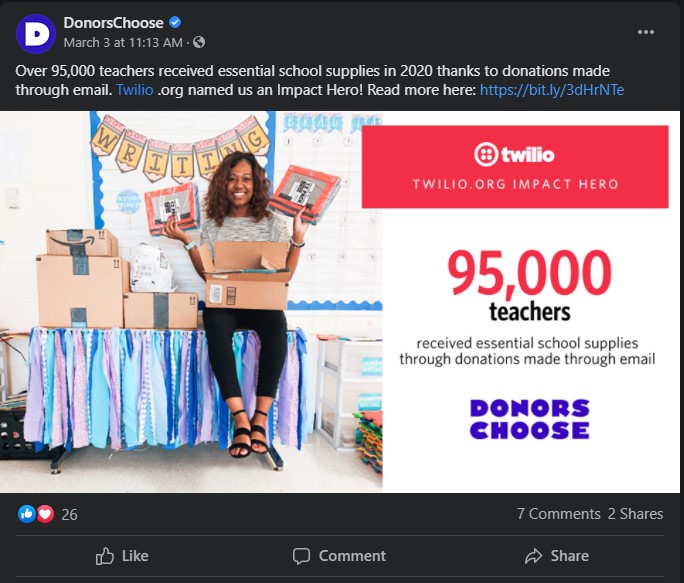Technology & Innovation
10 great examples of outcome metrics amplifying nonprofit storytelling

To succeed, your organization needs to stay connected to donors and funders by communicating the positive impact of your mission. Sharing your story can happen in many different ways, from your website and social media to targeted communications like emails, newsletters, church bulletins, presentations, and even on-site signage. These communications are stronger if you include not only the emotional benefits of your mission but also real-world facts and statistics about your outcomes and financial stewardship.
Outcome metrics are essential tools for demonstrating accountability and transparency. They can measure financial or non-financial criteria that reflect the efficacy of an organization, program, or initiative. Based on real-time statistical data, outcome metrics help create a rich picture of organizational performance. Many nonprofits obtain their best results by measuring across multiple dimensions for blended scorecards that encompass activities, capacities, financial results, and other metrics. Well-defined outcome measures help organizations continuously adapt and improve. They will also help you tell the story of your mission impact more effectively to the world.

Many nonprofit organizations simply don’t have the right financial management system in place to be transparent to donors and tell the story of their mission impact. The lack of real-time visibility into key performance metrics as well as the inability to measure outcomes were two of the top five internal frustrations cited by nonprofit finance leaders in the 2021 Nonprofit Technology Trends Report.
Further in the study, when ask about their role in telling the story of mission impact to constituents, 74% of nonprofit finance leaders indicated that their finance team is involved in telling their impact story, up from 64% in 2019. The increase in involvement by finance is an indication that the ability to report on data and nonprofit KPIs help tell a more power story of mission impact.
Nonprofits that rely on Sage Intacct can easily track financial key performance indicators and outcome metrics to demonstrate accountability and transparency. Real-time data keeps these metrics up-to-date at all times, so leaders can spot trends and adapt quickly to changing conditions. Let’s look at how some of Sage Intacct’s nonprofit customers are taking the lead in telling their mission stories using financial and outcome metrics.
Nonprofit education organizations know how to tell a meaningful story
One of the most time-tested and proven ways to teach and to learn is through pictures and storytelling. It should not be surprising that many nonprofit education-focused organizations do such a wonderful job telling people about their mission impact. These organizations tend to share metrics about how many children/people they’ve taught or how many educational resources they’ve delivered.
DonorsChoose uses Sage Intacct with other business systems like Salesforce to track and calculate their real-time outcome metrics. These are displayed right on the impact page of their website for all potential donors to examine. They’ve also made impact metrics part of their social media story.

Animal welfare organizations use metrics to make an emotional connection
Not much tugs at our heartstrings stronger than the adorable fuzzy faces of puppies and kittens. Many donors have pets as beloved members of their family, and they make emotional connections easily with abandoned or abused animals. Nonprofits in the animal welfare sector tend to use performance and outcome metrics to show donors the scale of animal need that exists and how much they are doing to meet that need.
PAWS Chicago uses images that grab attention and connect with donors, along with powerful metrics that demonstrate their effectiveness at achieving their mission. This no-kill animal organization has a 98.17% save rate. By displaying this metric out to hundredths of a percent, they show that every animal saved counts. They also display the tens of thousands of volunteer hours worked—a nice acknowledgment of the volunteers and a way to communicate strong stewardship to donors.
Churches and religious organizations demonstrate stewardship through outcomes
Faith-based organizations need to demonstrate two different areas of transparency and accountability. First, they need to show good financial stewardship over the gifts and tithes donated by the membership or congregation. That means being able to answer real-time questions about revenue and expenses from trustees, church councils, and even members. But beyond the financial operations of the church or organization itself, most churches and religious organizations perform outreach and ministry to their communities. The outcomes of these programs and activities are just as important — or more important — to donors than the budgets and expenses.
Seacoast Church provides financial transparency to its congregation by providing a link on its online giving web page to its 2020 Year in Review annual report. Anyone, at any time, can access this report and feel confident their gifts are achieving the purpose of the ministry. Additionally, the community at large can see the impact this church makes, potentially attracting new members to the congregation.
Human services organizations bring donors into the story with impact metrics
Human services organizations have an interesting challenge when soliciting donations. They must tell the story of human need — the scale of which is often immense — and find ways to help donors feel like the amount they give will make a real impact. Combining financial performance data with outcome metrics makes these stories shine. Suddenly, you can give a donor several levels of giving to choose amongst and define exactly how much impact that gift will create.
Real-time data from Sage Intacct helps Children’s Hunger Fund employ this technique very effectively on the donation page of their website. By knowing the exact amount spent per meal, they show donors how just $12 can provide a Food Pak with 48 meals for children. When you can show so much impact for such a small contribution, it allows even the smallest donors to feel great about getting involved in your mission.
Canine Companions for Independence also helps donors choose their donation level (and hopefully a bigger donation than originally intended) by demonstrating the real-world impact of each level of support. This helps donors see that, at any contribution level, they’re playing a vital role in the mission story, from providing a vest for a service animal to fully supporting the service required by a canine/human team.
International nonprofits and NGOs use storytelling to take donors around the world
Having a financial management system that tracks outcome metrics helps organizations tell powerful stories about big-picture, global mission impact. With international nonprofits and NGOs working in far-flung corners of the world, it is also important to help donors drill down by showcasing your organization’s impact on a single person, family, or community.
Room to Read visualizes the global nature of its mission and impact using a map on its website. They also maintain an evergreen “Literacy Program Dashboard” on the website where donors can see the total impact of their mission since its founding. Additionally, Room to Read tells smaller stories in more detail. For example, a recent social media post shared the story of how their programs improved the life of one alumna.
World Learning shares a variety of outcome metrics in their storytelling, but one recent example really stood out. In the wake of COVID-19, the organization gathered a specific set of metrics demonstrating how effectively they were able to respond to the global pandemic. We love the part played by Sage Intacct in helping World Learning demonstrate adaptability and resilience during this challenging time.
Nonprofit health organization ties gifts to impact
Nonprofit health organizations don’t often provide outcome metrics in a public-facing way. But with the right financial management system capturing both financial and statistical metrics, healthcare organizations can certainly showcase their impact, if they choose.
Tri-County Mental Health Services invites the public to donate to help people with mental illness in the community. Using the financial expense information they track in Sage Intacct, the organization shows donors the exact impact that will be made by their donations at the $50, $100, and $500 level.
Nonprofit organizations demonstrate economic impact
If your organization helps to invest in the community to generate business and economic impact, you will definitely want to provide financial transparency and demonstrate outcomes. These types of nonprofits often provide metrics about the amount of funds deployed or volunteer time invested, how money and programs impacted those that received it, and how the efforts will make a sustained, positive impact on the community.
Jumpstart Inc. makes investments in Ohio startups and small businesses. Not only do they share financial performance and outcome metrics to demonstrate mission impact, but they also measure that impact on specific groups within the community, namely women and people of color. After the COVID-19 challenges of 2020, the organization also shared an entire blog post about their outcomes, to keep funders and constituents informed about all the ways they were able to continue their mission in the face of adversity.
SCORE is the nation’s largest network of volunteer business mentors and works to help entrepreneurs get new businesses off the ground, to the benefit of the economy and community. They’ve dedicated an entire page on their website labeled “Our Impact” that weaves in outcome and performance metrics to demonstrate how they are helping “small businesses achieve big success.”
Conclusion
Some types of nonprofit organizations, such as education, human services, and NGOs, speak about outcome metrics regularly in their donor communications. It’s an important piece of their mission story. Other sectors of nonprofits, such as the arts, community development, health-related, and membership associations, tend to offer fewer outcome metrics and impact stories. But, with the right financial management system, any type of nonprofit organization is equally able to set up dimensions to capture data and report on the outcome metrics that matter most in their mission.
Learn more about how to track and use outcome metrics to tell your mission story to donors and funders. Download our eBook, Outcome Metrics: Measuring What Matters in the Nonprofit World.







Ask the author a question or share your advice